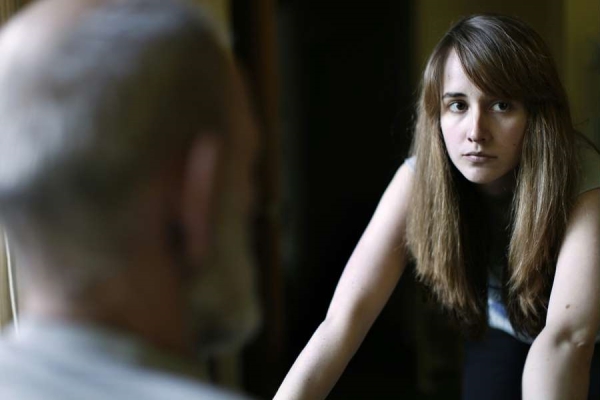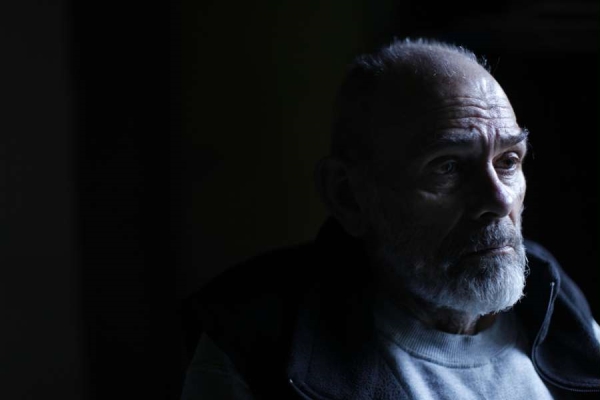Unplugged
To start the New Year, the Museum introduces First Look, a new annual showcase curated by Dennis Lim, Rachael Rakes, and David Schwartz. This two-weekend program—which brings together some of the most invigorating and inventive voices in contemporary world cinema, including established and emerging filmmakers—affirms our belief in cinema as a flourishing art form. To supplement the program, Moving Image Source is running a series of essays on all the feature films that are being shown. Check back daily from now through next weekend for new articles.
As celluloid cinema inexorably marches toward death—or, at the very least, a permanent exile in the ghetto of the avant-garde—certain choices faced by those not willing to follow it to the grave are time and again ignored as financial facts:
A) In order to afford to make Movie X on Budget Y, it must be shot digitally
B) Movie X exists, so
C) The decision to shoot Movie X digitally was a financial, rather than aesthetic, decision.
This line of logic is undoubtedly true in many cases, but that truth in and of itself isn’t a substitute for a consideration of why shooting Movie X digitally was acceptable,1 or, moreover, the extent to which Director Z chose to engage this new technology. If there’s a financial component to the use of HD by directors like Fincher and Mann (and of course there is), their move to digital is nonetheless acknowledged as the product of an artistic consciousness because of its garish digitalness, in contrast to the work of a Hollywood system where, even as it digitizes wholesale, the highest compliment paid to each new HD camera is that it looks just like film . . . but better (read: cheaper).
Meanwhile, in the new underclass of the microbudget indie, digital photography is simply taken as a given, the handful of directors still shooting on 16mm singled out and applauded for their commitment to film as film, for making "gritty" films, etc. As a result it has become incredibly easy for the digital independent film to utterly neglect the very medium that it exists in. This passive aesthetic acceptance is, in many cases, logically folded into scenarios and performances: the ubiquitous creation of digital images in each of our lives on a daily basis creates a parallel that’s as true as it is misleading. Now, when the modes of production converge, one dream of vérité is lived, but at the height of naiveté; lived life might now be captured exactly in the form of fictional narrative, but at the cost of further obscuring the ever growing gap between our inner and outer selves that the digital world facilitates so warmly. The best of these microbudget DV films are those that have managed to make use of this digital convergence without sacrificing a keen awareness of the stakes of pervasive mediation.2
Mark Jackson’s Without, which triangulates Persona, Repulsion, and Antichrist into a vision of desperate youth, not only reflects on its medium, it turns that reflection into the basis of its entire conceptual project. Joslyn Jensen gives an exceptionally well-modulated performance as Joslyn,3 a 19-year-old tasked with looking after a nearly comatose old man named Frank while his family’s away; as she copes with an apparent personal loss, and the terror of not having an Internet connection or cell phone service (despite having 600 TV channels, the Pacific Northwest island home has neither of these creature comforts), she coolly descends into something verging on hysteria. Much of the reception has treated the film exclusively in psychological terms —“Stunningly evocative!” says Variety—because this is the register that a decade of similar features has established as home turf. If I don’t find it particularly engaging on that level that’s only a matter of taste, but what sets Without apart from the thousand and one stories of the various traumas suffered by affluent, articulate young people is the extent to which it internalizes the mechanics of its, and its characters', existence and incorporates those—which, I’ll argue, are uniquely digital—as the real specter that’s lurking at its edges.

Joslyn Jensen in Without
In its cataloging of Joslyn’s matronly activities with catatonic grandpa Frank—feeding him, wiping his ass, getting him into bed (plus some yoga and running on the elliptical machine in her free time)—Without reconfigures Jeanne Dielman’s perspicacious obsession with daily process into its logical 21st-century form: the autistic need to capture every event as a reminder that it did in fact occur.4 Joslyn herself is equally image-obsessed, constantly searching for a signal to check Facebook and settling for flirty old cell phone videos of herself and another girl: Is it her girlfriend? Is the girl, in this film called Without, deceased? Do these videos really matter as anything other than one of the dozen or so points of ambiguity that give the film its mock thriller structure?
I’ll leave the first two for you to find out. As to the third, yes, they matter quite a bit, right along with all the other genre trappings that Jackson wedges in (a mysterious bruise, an inexplicably wandering cell phone, a local Casanova and his hysterical irrational girlfriend, the family Joslyn finds herself housesitting for). Each is only a varnish of gleeful shlock over a profoundly contemporary terror: the forced confrontation with the ways in which forces beyond our control—perhaps call these “life”—derail our best efforts at molding our lives into the perfect narrative. To accomplish this Jackson tweaks the conventional logic that renders inner turmoil grotesquely, the better to psychoanalyze it (c.f., Black Swan), into a kind of everyday expressionism, which means that, for example, the family Joslyn’s housesitting for has to be rendered as a caricature that’s both ridiciulous and mundane, because only as such can they shatter the continuity of the narrative she’s arranged for herself. This ultimately makes for a film that’s more or less dramatically inept according to any traditional rubric, and more precise in its evocation of this generational tragedy than any of its peers.

Ron Carrier in Without
The island home’s lack of Internet connection, which leads to Joslyn digging up an old PC and webcam and, after a few failed attempts at getting a dial-up connection, treating it as a pure receptacle, a stymied source of transmission that, like the cell phone she uses to record herself singing a mash-up of “Lollipop” and “Buy U A Drank,” will accept her images but can only offer her the reassurance that they’ve been captured.5 Every image becomes a self-image, a neurosis that Jackson brings out beautifully in a scene involving the shared gaze between Joslyn and a deer outside a window and then modulates across the film by setting her own fraught perception of her body in contrast to Frank’s decrepitude—they’re blended corporally via montage in one scene as Joslyn cleans Frank while she prepares for her own date. Joslyn surveys her naked body—the body that, remember, the film spends a significant portion of its runtime showing her working to improve—and can only be disappointed: death and perfection sit side by side on the horizon, neither the fulfillment of the desired personal narrative.
It’s here that the most poignant of the title’s many connotations becomes apparent. Joslyn, left alone with only an audience (a catatonic man, a computer, a phone) incapable of responding, finds herself stuck in a feedback loop wherein she has only the sound of a schizophrenic voice inside her head for company, a voice that both creates and critiques her desires. Twice she masturbates—the first time after glimpsing her reflection in a window at night, the second in front of the webcam after failing to elicit a sexual response from Frank—and it’s in this action that the terror of her situation is most clearly manifest: pleasure has been replaced by the compulsive need to engage with one’s self, a desperate search inside for the audience that life has removed from the equation.
The first four shots of Without compose a cubist portrait of Joslyn, asserting the singularity of her existence as a body . . . being . . . person . . . performer. The penultimate image sees her, for the first time, turn her camera elsewhere, as she snaps a picture of a bay at dusk, the sole image of Joslyn accepting a world outside of herself (even as she compulsively catalogs it). The credits begin, and then a final image: Joslyn and the girl, in the same setting we’ve seen them before, their self-shot 4:3 cell phone image usurping Jackson’s 16:9 frame to become both life and cinema, come together and kiss. There’s an undeniable, and genuinely affecting, sentimentality here, the realization of a personal loss that has left a young girl adrift in a world that can no longer tolerate solitude even as it pushes us toward it. As they connect personally in a very traditional manner the modern creation of narrative is woven in. It’s not enough to set up a false dichotomy between mediation and experience—the old comfort of the former is no longer distinguishable from the everyday uncertainty of the latter. Jackson doesn’t have any answers for how to live today, but in showing that narrative now is experience, he points toward a source of anxiety that, by nature, hides inside the process of its creation. That’s a worthy first step.
_________________________________
1. The major narrative in American independent cinema in the digital age is that of the young maverick, unconcerned with all the old institutional barriers to making a movie, out there making the movies he was born to make: the real birth of the caméra-stylo. The joy (or headache, depending on the viewer) of their very existence clouds a consideration of how these movies exist.
2. Kentucker Audley’s extraordinary Holy Land balances these impulses better than any other film that I’m aware of.
3. The trend toward nominally collapsing actor and character being among the tidiest ways to underline the cinema-life convergence afforded by digital.
4. The quality of the image itself is of little importance; details can be freely sacrificed to shallow focus, deployed by Jackson as both a signifier of immediacy and an expressionist rendering of Joslyn’s isolation. If once the image served mnemonically by offering a detailed impression of a past scene, it now functions as something subordinate to memory, the first switch to be flipped in our memorial recall: we’re both more and less trusting of our capacity to remember than ever before.
5. If a girl in the woods takes a picture of herself and no one gets to "like" it on Facebook, etc. ![]()
LATEST ARTICLES
-20140814-173707-thumb3.jpg)
Fighting Words
by Imogen Sara Smith
posted August 12, 2014

Fighting Words, Part 2
by Imogen Sara Smith
posted August 20, 2014

On the Margins: The Fil…
by Andrew Chan
posted August 12, 2014

Robin Williams: A Sense…
by David Schwartz
posted August 12, 2014
RELATED ARTICLE
Jungle Fever by Andréa PicardGoing the Distance by Scott MacDonald
Glass Houses by Michael Sicinski
Ghost World by Colin Beckett
Darkness Doubled by Leo Goldsmith
Island Time by R. Emmet Sweeney
A Nude by Garrel by Eugenio Renzi
Twilight Zone by Robert Koehler
Family Viewing by Mark Peranson
Capitalist Punishment by Shelly Kraicer
Her Own Devices by Robert Koehler
The Fallen by Phil Coldiron
The 1 Percent Solution by Michael Sicinski
More: Article Archive
THE AUTHOR
Phil Coldiron is a writer and programmer living in Brooklyn.
More articles by Phil Coldiron

